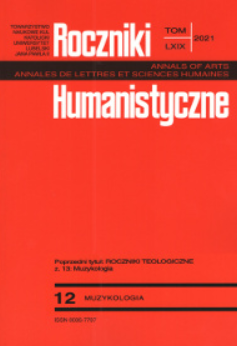NEAPOLITAŃSKA PRAKTYKA WYKONAWCZA W INSTRUMENTALNEJ MUZYCE ZESPOŁOWEJ XVIII WIEKU
NEAPOLITAN PERFORMANCE PRACTICE IN THE INSTRUMENTAL ENSEMBLE MUSIC OF THE EIGHTEENTH CENTURY
Author(s): Piotr WilkSubject(s): Cultural history, Music, 18th Century, History of Art
Published by: Towarzystwo Naukowe KUL & Katolicki Uniwersytet Lubelski Jana Pawła II
Keywords: Naples; instrumental music; performing practice; scoring types;
Summary/Abstract: When we talk about the Neapolitan school, we usually mean the composers of opera and vocal music, although multicoloured instrumental works were also developing in Naples. Knowledge of these is poor, even among those researching this centre of music. The subject of this article is thus the Neapolitan instrumental work for various types of chamber and orchestral ensembles created over a period of 100 years, starting from the 1690s. Neapolitan performing practices differed from those known in other European centres. Despite practising the same genres (sonata, concerto, symphony), Neapolitan composers displayed different preferences for the scoring of music. Regardless of the genre, they were fond of an ensemble consisting of three or four violins and a bass voice. They avoided use of the viola: less frequently, they used the violin as a solo instrument, but more preferably flutes, a cello, a mandolin and keyboards. It was not the type of scoring of music in Naples that determined the choice of genre (sonata, concerto or symphony), but rather the texture and form. The musical genre also had no influence on whether the piece would be performed by chamber or orchestral ensemble.
Journal: Roczniki Humanistyczne
- Issue Year: 69/2021
- Issue No: 12
- Page Range: 31-49
- Page Count: 19
- Language: Polish

